subscribed
You are using an out of date browser. It may not display this or other websites correctly.
You should upgrade or use an alternative browser.
You should upgrade or use an alternative browser.
Spike Flex Plus Owners
- Thread starter paulymd
- Start date

Help Support Homebrew Talk:
This site may earn a commission from merchant affiliate
links, including eBay, Amazon, and others.
Gregory T
Well-Known Member
- Joined
- Mar 7, 2018
- Messages
- 215
- Reaction score
- 64
I open ferment s
I have no use for yeast dumping. You see. To believe it is the end all be all to fermentation. I have no idea what you brew. I brew Trappists. Mostly Tripels. They sit on the yeast for 3 weeks and cold crash on the yeast for another 2. They do reasonably well in competitions. And most importantly I like them
The flex and flex plus work great for me. However the CF5 is a great fermentor. But to do what I can do with a flex would require a glycol chiller that I didn’t have to worry about my dogs getting into, and more space
no worriesI never toured chimay (although I did bring some home a few years back and compared it with locally obtained chimay along with other brands and found the stuff that makes its way to the states through proper channels is pretty skunky from the 6 week average in hot storage containers on the ocean so many in the states dont realize what it supposed to taste like anyway.)
I realize your just trying to argue a point here but again that style of beer and those results are not typical or relevant to this discussion as the results would not likely be any different with the flex vs using a conical and not dumping right? Are the monks using pressurized fermenters? BTW thanks for this comment because you reinforced what I was trying to say about a fermenter having an effect on the beer it produces depending on how they are used and limitations..
In this case the flex is limited to being the same as the cf5 being compared in functionality if the dump valve is not used but at the same time gives advantages on beer styles such as IPAs or lagers where one would certainly want to use it. Ironically the cf5 is MORE flexible that the flex as far as options and flexibility of use short of size when used in a size limiting chamber.
This lack of a functional conical drain bottom is due to size and price constrictions here they were not excluded for any other reason related to the quality of the beer made. The flex is literally a mini brite tank by design (only those also have center drains) giving it advantages over other bucket style fermenters that wont hold pressure but disadvantages against the more expensive stainless or cheaper plastic dedicated fermenters spike or others sells that should be discussed good or bad for people to compare.
... Im sure their sours would taste different too if they stopped using open attic coolship type fermenters... I doubt there are a lot of folks reading this thread that are exclusively brewing one of these unique styles that any change after centuries would be considered negative regardless but point made... I guess im referring to the vast majority of the beer styles were brewers want cleaner fermentation and beer. I bet many of the brewers using these are even taking steps to keep the trub out of the beer not realizing that with a conical and dump valve a person could wait for it to settle to the bottom of the conical and easily dump it all from the bottom an hour after its been filled. Lastly, My comments here are for the folks reading and comparing. Those trying to decide and weighing a conical vs a bucket style. not for those who already made their decision. In hindsight I normally know better than to discuss things like this in a thread intended for owners despite it being the first place potential buyers would look for feedback. There are two similar threads going on and To be honest I didnt pay much attention to which was which since the same conversation more or less was going on in both but I would have otherwise been more and cautious. Sorry if this comparision or information is bothering anyone who doesnt want to hear it. I will refrain from derailing the thread any further than I apparently already have.
I didnt mean to be "that guy" who brings beer to the party only serving hard seltzer and bud here..
I have no use for yeast dumping. You see. To believe it is the end all be all to fermentation. I have no idea what you brew. I brew Trappists. Mostly Tripels. They sit on the yeast for 3 weeks and cold crash on the yeast for another 2. They do reasonably well in competitions. And most importantly I like them
The flex and flex plus work great for me. However the CF5 is a great fermentor. But to do what I can do with a flex would require a glycol chiller that I didn’t have to worry about my dogs getting into, and more space
I reviewed the flex+ on spikes site and mentioned that the clear 4" lid doesn't seal. A few days later Spike emailed me and had already shipped me a new style gasket made of a different material that they say solves the issue. This is without a formal complaint or email on my part.
That is EXCELLENT customer service imo.
That is EXCELLENT customer service imo.
I reviewed the flex+ on spikes site and mentioned that the clear 4" lid doesn't seal. A few days later Spike emailed me and had already shipped me a new style gasket made of a different material that they say solves the issue. This is without a formal complaint or email on my part.
That is EXCELLENT customer service imo.
How did you verify that the clear lid wasn't sealing? Were you able to check it by spraying it down with StarSan and visibly seeing a leak? I'm curious if I'm having this issue as well. I have a Sculpin clone in one of my Flex+ with the clear lid. Checked gravity on Thursday and it was around 5 points of expected final gravity. Put my dry hops in and spunding valve still attached and increased temp to 72F to help it finish out and clean up. Not seeing any pressure on the gas manifold now 4 days later. Going to try giving it 2-4PSI CO2 today after work to see if it holds pressure at the set temperature.
RiverCityBrewer
Well-Known Member
Mine only holds to about 5psi with the clear lid as well. Used it with both a silicone and buna gasket with same results. Metal lid seals fine, but on the clear lid I can see air bubbles pushing between the gasket and the clear lid. To get it to hold 5 I had to use a lot of keg lube and really play with the clamp to find the optimal clamping pressure. I'll contact them about their newer gasket and see if that helps.
I am on my second batch using the base model flex with a glass cap. I used a 3-piece airlock on the first and an S on the second. I never saw a bubble in the first and so far have not seen one on the second, either. Looks like I need the newer gasket as well.
There is no real risk to my beer under this scenario, is there? I've not tried a pressurized transfer nor much of anything else so far.
There is no real risk to my beer under this scenario, is there? I've not tried a pressurized transfer nor much of anything else so far.

$176.97
1pc Commercial Keg Manifold 2" Tri Clamp,Ball Lock Tapping Head,Pressure Gauge/Adjustable PRV for Kegging,Fermentation Control
hanhanbaihuoxiaoshoudian

$39.22 ($39.22 / Count)
Brewer's Best Home Brew Beer Ingredient Kit - 5 Gallon (Mexican Cerveza)
Amazon.com

$22.00 ($623.23 / Ounce)
AMZLMPKNTW Ball Lock Sample Faucet 30cm Reinforced Silicone Hose Secondary Fermentation Homebrew Kegging joyful
无为中南商贸有限公司

$10.99 ($31.16 / Ounce)
Hornindal Kveik Yeast for Homebrewing - Mead, Cider, Wine, Beer - 10g Packet - Saccharomyces Cerevisiae - Sold by Shadowhive.com
Shadowhive

$58.16
HUIZHUGS Brewing Equipment Keg Ball Lock Faucet 30cm Reinforced Silicone Hose Secondary Fermentation Homebrew Kegging Brewing Equipment
xiangshuizhenzhanglingfengshop

$7.79 ($7.79 / Count)
Craft A Brew - LalBrew Voss™ - Kveik Ale Yeast - For Craft Lagers - Ingredients for Home Brewing - Beer Making Supplies - (1 Pack)
Craft a Brew

$53.24
1pc Hose Barb/MFL 1.5" Tri Clamp to Ball Lock Post Liquid Gas Homebrew Kegging Fermentation Parts Brewer Hardware SUS304(Liquid Hose Barb)
yunchengshiyanhuqucuichendianzishangwuyouxiangongsi

$27.29 ($13.64 / Count)
$41.99 ($21.00 / Count)
2 Pack 1 Gallon Large Fermentation Jars with 3 Airlocks and 2 SCREW Lids(100% Airtight Heavy Duty Lid w Silicone) - Wide Mouth Glass Jars w Scale Mark - Pickle Jars for Sauerkraut, Sourdough Starter
Qianfenie Direct
![Craft A Brew - Safale S-04 Dry Yeast - Fermentis - English Ale Dry Yeast - For English and American Ales and Hard Apple Ciders - Ingredients for Home Brewing - Beer Making Supplies - [1 Pack]](https://m.media-amazon.com/images/I/41fVGNh6JfL._SL500_.jpg)
$6.95 ($17.38 / Ounce)
$7.47 ($18.68 / Ounce)
Craft A Brew - Safale S-04 Dry Yeast - Fermentis - English Ale Dry Yeast - For English and American Ales and Hard Apple Ciders - Ingredients for Home Brewing - Beer Making Supplies - [1 Pack]
Hobby Homebrew

$53.24
1pc Hose Barb/MFL 1.5" Tri Clamp to Ball Lock Post Liquid Gas Homebrew Kegging Fermentation Parts Brewer Hardware SUS304(Liquid Hose Barb)
Guangshui Weilu You Trading Co., Ltd

$20.94
$29.99
The Brew Your Own Big Book of Clone Recipes: Featuring 300 Homebrew Recipes from Your Favorite Breweries
Amazon.com

$33.95
Five Star - 6022b_ - Star San - 32 Ounce - High Foaming Sanitizer
Bridgeview Beer and Wine Supply
I've only done one batch, but didn't notice anything suspicious. Mine is the Plus, but I didn't do a pressurized fermentation or use my spunding valve. I did have activity with the blow-off hose, so who knows.
I thought about filling mine with about 5-6 gallons of water, hit it with about 10psi of co2 and see if it there's any leaking around the clear cap. 15psi is the limit and if nothing is happening below 5psi, then maybe 10 is the magic number. Thoughts?
I thought about filling mine with about 5-6 gallons of water, hit it with about 10psi of co2 and see if it there's any leaking around the clear cap. 15psi is the limit and if nothing is happening below 5psi, then maybe 10 is the magic number. Thoughts?
I am on my second batch using the base model flex with a glass cap. I used a 3-piece airlock on the first and an S on the second. I never saw a bubble in the first and so far have not seen one on the second, either. Looks like I need the newer gasket as well.
There is no real risk to my beer under this scenario, is there? I've not tried a pressurized transfer nor much of anything else so far.
You should be ok. You're going to have more positive pressure during the active part of fermentation anyway, so nothing should be going into the fermenter.
Thanks. I transferred the first batch to a keg for spunding, and it came out pretty good, so I wasn't too worried about it. I am just glad to know where the leak is likely to be. I've already reached out to Spike.
I was able to observe a leak through the top of one of my Flex+ and clear cap combinations. Pressurized it to around 3PSI today while home for lunch and it was at 0 when I got home about 5 hours later. Emailed Spike with a picture of the leak location to see if they have a recommendation.
How do I pressurize the Flex, not the Flex+? It is currently in use as a fermenter.
Buy the fancy lidHow do I pressurize the Flex, not the Flex+? It is currently in use as a fermenter.
The fancy lid is on order. Spike wants me to pressurize it NOW as part of troubleshooting the lack of bubbles in my airlock during fermentation. Earlier discussion in this thread leads me to suspect the gasket on the clear lid.
Supposedly, the base model flex can be pressurized up to 2 psi. I need to fill that big hole in the lid and get gas into the fermentation chamber. I have a soda bottle carb cap, if that helps, but so far I've not found a way to make it fit.
Supposedly, the base model flex can be pressurized up to 2 psi. I need to fill that big hole in the lid and get gas into the fermentation chamber. I have a soda bottle carb cap, if that helps, but so far I've not found a way to make it fit.
The fancy lid is on order. Spike wants me to pressurize it NOW as part of troubleshooting the lack of bubbles in my airlock during fermentation. Earlier discussion in this thread leads me to suspect the gasket on the clear lid.
Supposedly, the base model flex can be pressurized up to 2 psi. I need to fill that big hole in the lid and get gas into the fermentation chamber. I have a soda bottle carb cap, if that helps, but so far I've not found a way to make it fit.
I know this is not a flex but you could do the same idea by pushing CO2 into the airlock that is in the stopper. I would just be careful not to over pressurize.
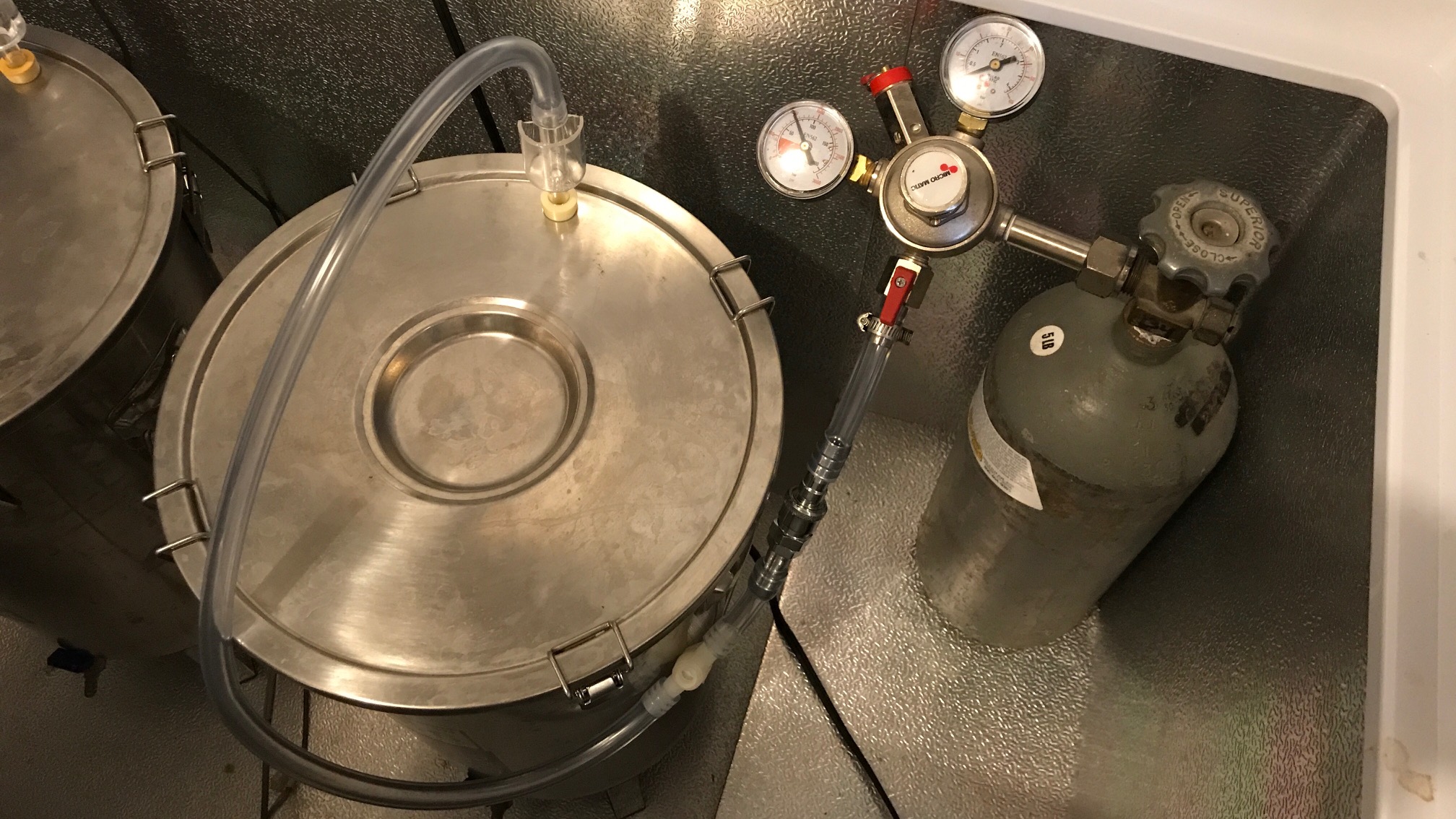
That worked perfectly, thank you. I took apart a three piece airlock and jammed one end of a tube into that. I pushed the barb on the end of a soda carb cap into the other end, and connected my gas line to that. The result was just barely long enough to reach without having to take things about nor remove the Flex from the chest freezer that I use as a fermentation chamber. I turned the gas on low and the clear lid promptly started to whistle. I pressed down on the lid, and the whistling stopped. This should convince Spike that we have found the problem.I know this is not a flex but you could do the same idea by pushing CO2 into the airlock that is in the stopper. I would just be careful not to over pressurize.
So, I've never done a pressure or closed transfer before. I have a beer basically finished in my spike plus. Cold crashing now. I have a new corny keg I cleaned and then filled to the top with starsan. Pushed the star San out with c02. I have the Spike closed pressure transfer kit and I bought another gas post for the other end. If my keg is at higher pressure than my fermenter would that be enough to get the beer going into the keg? (Keg gas hooked to fermenter gas post. Liquid out of butterfly valve into liquid keg post)
Or would the beer kinda just stop flowing once equal pressure was reached? (And then I just hook a c02 tank up to flex gas post and lift the keg prv a lil here and there until finished?
I've never done this before and if I'm gonna bother I'd like it to go right the first time.
Thanks, guys
Or would the beer kinda just stop flowing once equal pressure was reached? (And then I just hook a c02 tank up to flex gas post and lift the keg prv a lil here and there until finished?
I've never done this before and if I'm gonna bother I'd like it to go right the first time.
Thanks, guys
Pressure seeks equilibrium. Pressure (and beer) will move in the direction of the lower pressure. You want lower pressure in the keg. Lifting the keg PRV will lower pressure in the keg and allow the beer to flow.
Mine only holds to about 5psi with the clear lid as well. Used it with both a silicone and buna gasket with same results. Metal lid seals fine, but on the clear lid I can see air bubbles pushing between the gasket and the clear lid. To get it to hold 5 I had to use a lot of keg lube and really play with the clamp to find the optimal clamping pressure. I'll contact them about their newer gasket and see if that helps.
Any word from Spike? Just curious what they said.
This past weekend, I pressure tested my CF10 to see if the clear lid had issues. It does. I'm sure the clear lid for the Flex + would be the same.
I love the idea of the clear lid. What sucks though is it doesn't seal and it fogs up bad during active fermentation.
So, I've never done a pressure or closed transfer before. I have a beer basically finished in my spike plus. Cold crashing now. I have a new corny keg I cleaned and then filled to the top with starsan. Pushed the star San out with c02. I have the Spike closed pressure transfer kit and I bought another gas post for the other end. If my keg is at higher pressure than my fermenter would that be enough to get the beer going into the keg? (Keg gas hooked to fermenter gas post. Liquid out of butterfly valve into liquid keg post)
Or would the beer kinda just stop flowing once equal pressure was reached? (And then I just hook a c02 tank up to flex gas post and lift the keg prv a lil here and there until finished?
I've never done this before and if I'm gonna bother I'd like it to go right the first time.
Thanks, guys
I bought these from Bobby M
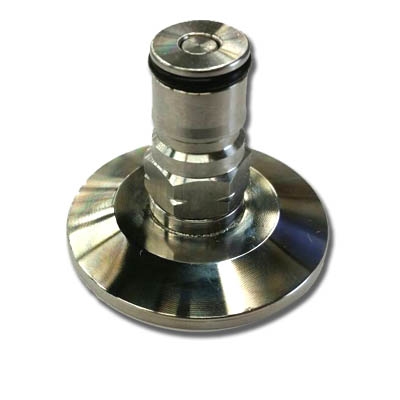
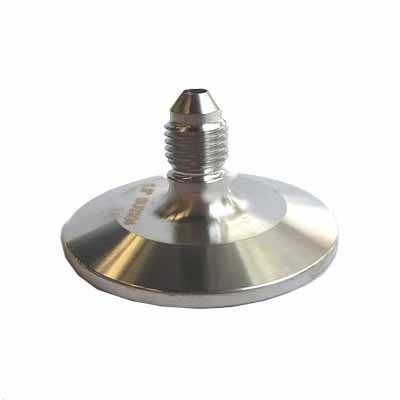
The MFL/1.5 triclamp you won't need since you have the transfer kit. I bought mine as it was cheaper to make my own transfer line than the kit offered by Spike. I already had everything else but the triclamp adapter pictured.
I connected the line to my fermenter but with the beer disconnect off. I opened the butterfly valve and let the beer run clear, then close it. I connected the (sanitized) disconnect, and attached it to the sanitized/purged keg. Then I hooked up CO2 to the gas post on the Spike Flex, opened the Spike's valve, then the keg's PRV and let it fill.
RiverCityBrewer
Well-Known Member
I did contact them and sent a few pictures. They sent me some new EPDM gaskets but I haven't had a chance to test them out yet. The gasket does seem a little thicker than the silicone one it came with, so I'm hopeful it will clamp evenly and hold full pressure.Any word from Spike? Just curious what they said.
This past weekend, I pressure tested my CF10 to see if the clear lid had issues. It does. I'm sure the clear lid for the Flex + would be the same.
I love the idea of the clear lid. What sucks though is it doesn't seal and it fogs up bad during active fermentation.
They told me one was in the mail like 10 days ago.I did contact them and sent a few pictures. They sent me some new EPDM gaskets but I haven't had a chance to test them out yet. The gasket does seem a little thicker than the silicone one it came with, so I'm hopeful it will clamp evenly and hold full pressure.
Never got it
RiverCityBrewer
Well-Known Member
Did you get a tracking number?They told me one was in the mail like 10 days ago.
Never got it
When I tracked mine, it appeared several days passed between the time they created the shipping label and the time it actually went to the shipper.
Today, they followed up and asked if it solved the problem for me. I thought that was a nice touch.
Today, they followed up and asked if it solved the problem for me. I thought that was a nice touch.
Here is my modified flex. I had my brother cut the point of the cone off and weld a 1.5” tri-clamp fitting to it. The fitting was about $8 on amazon and allows me to use any of the pieces I have already purchased for the flex. He was able to do all the work rather quick, maybe 30 minutes, so I don’t think it would cost a lot. He only charged me beer whenever he comes over. Not sure other welders would do the same though. Overall I’m happy with it and I feel I saved quite a bit even including the cost of all the attachments and clamps from amazon. Just gotta passivate the weld and I’m set. Waiting on my Anvil Foundry to get here to break it in.
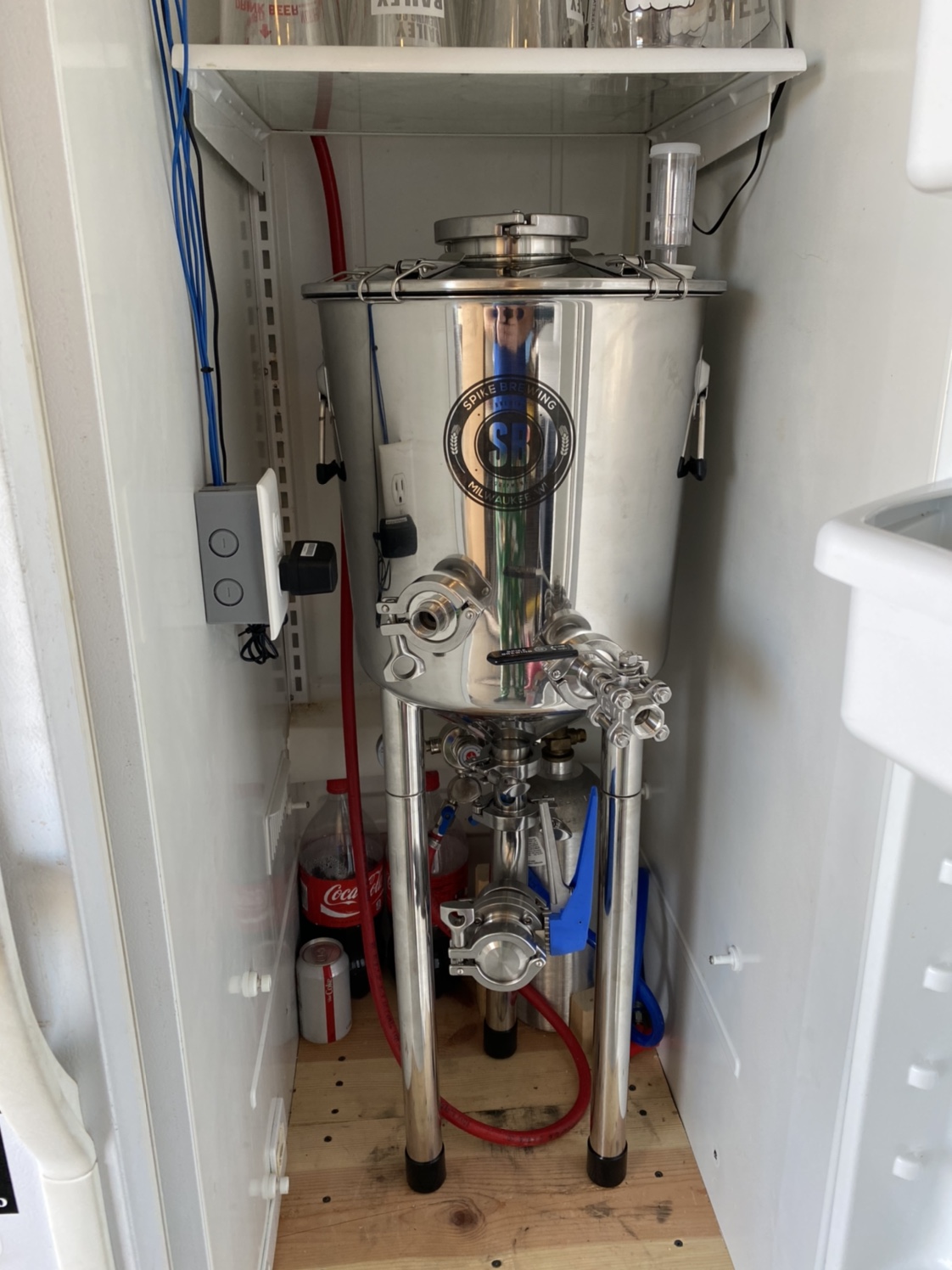
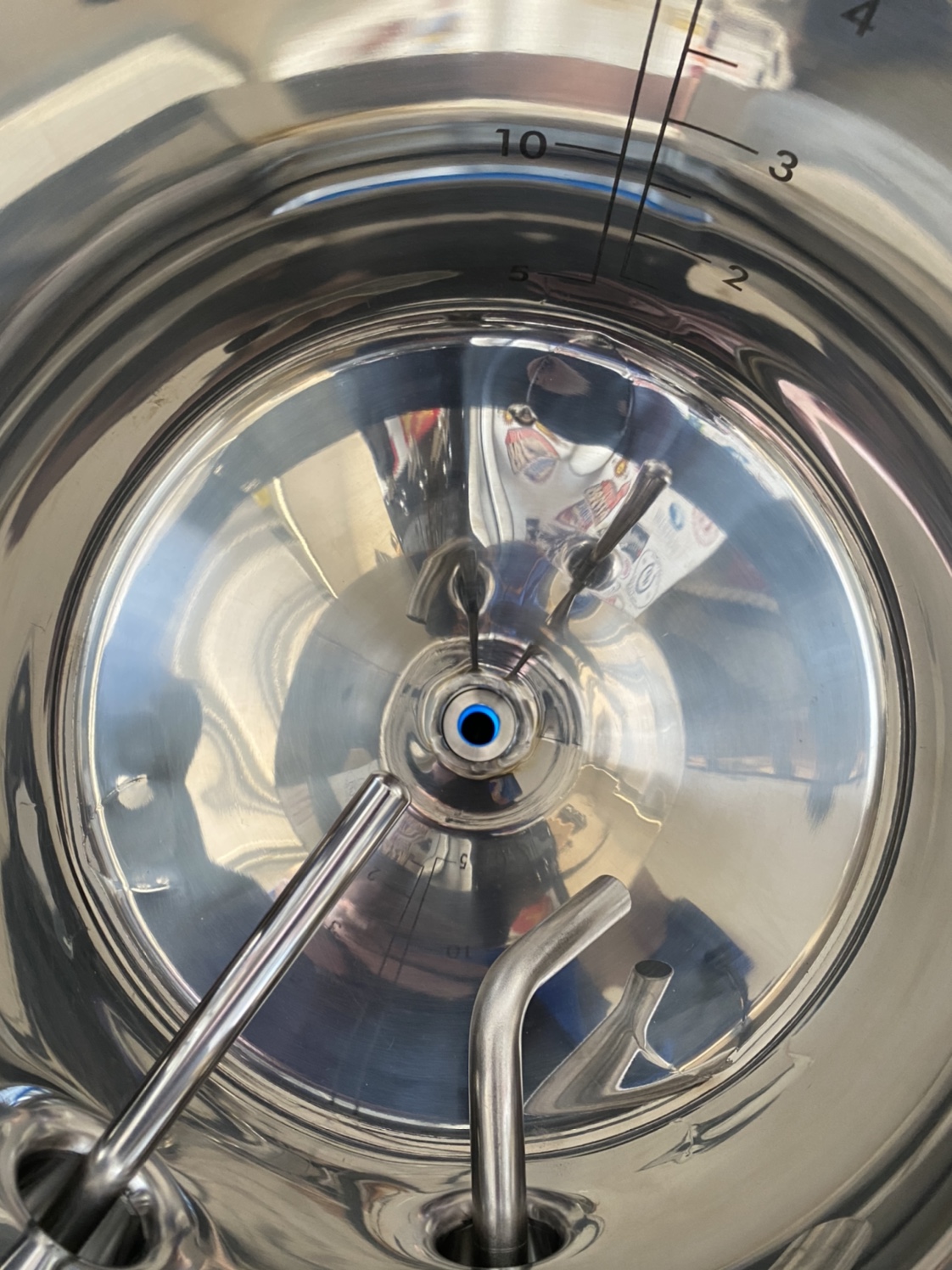

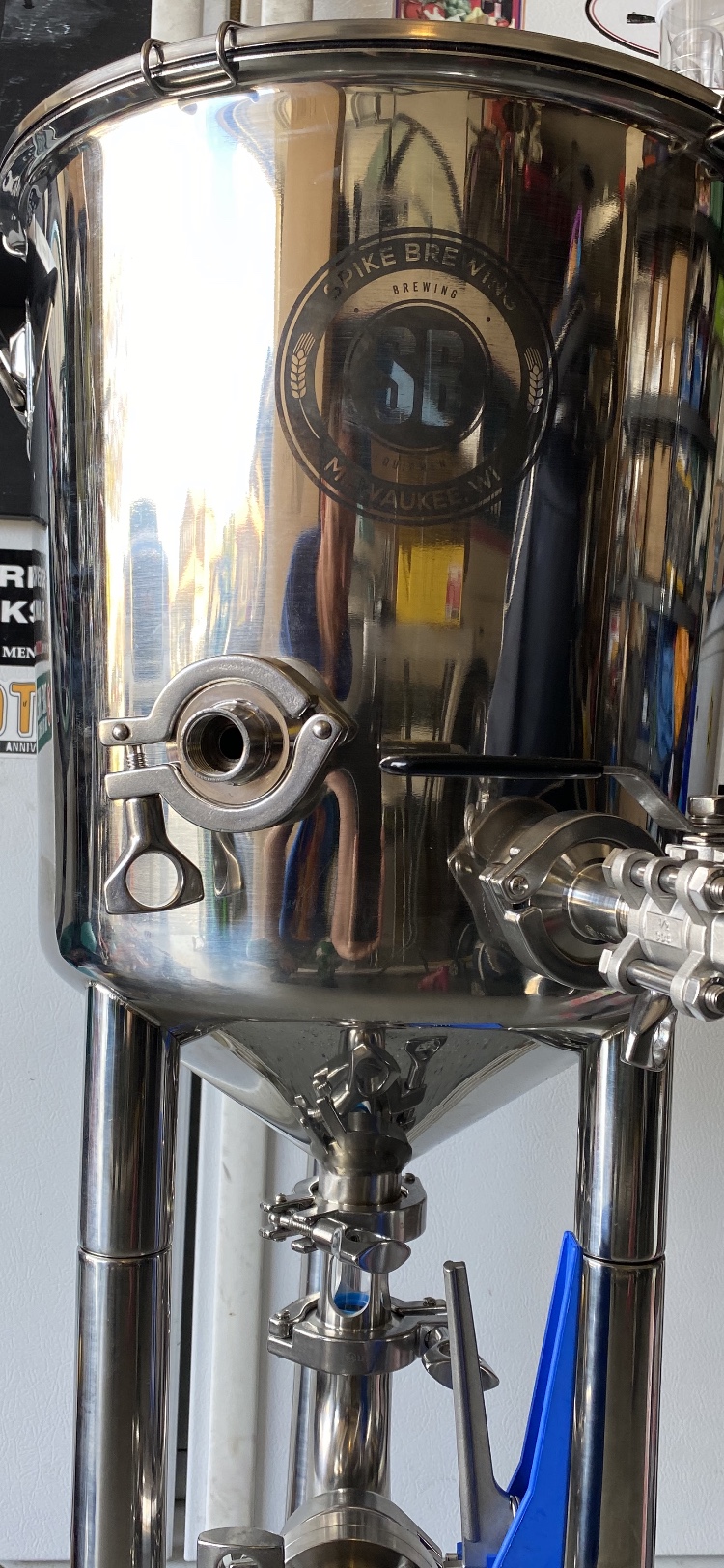




I use a tilt hydrometer in my flex plus. After my first beer in it I went and bought the repeater.
Reading in here recently that hydrometers aren't accurate when carbed.
I let my beer finish under pressure and am now wondering how much the hydrometer reading was effected. It finished at my expected FG almost exactly.
Inside a closed fermenter under pressure will a hydrometer read correctly?
The reasons I read a hydrometer doesn't work in carbed beer is due to co2 offgassing moving the hydrometer up. In a closed fermenter under pressure does the same problem occur?
Thanks, guys
Reading in here recently that hydrometers aren't accurate when carbed.
I let my beer finish under pressure and am now wondering how much the hydrometer reading was effected. It finished at my expected FG almost exactly.
Inside a closed fermenter under pressure will a hydrometer read correctly?
The reasons I read a hydrometer doesn't work in carbed beer is due to co2 offgassing moving the hydrometer up. In a closed fermenter under pressure does the same problem occur?
Thanks, guys
I use a tilt hydrometer in my flex plus. After my first beer in it I went and bought the repeater.
Reading in here recently that hydrometers aren't accurate when carbed.
I let my beer finish under pressure and am now wondering how much the hydrometer reading was effected. It finished at my expected FG almost exactly.
Inside a closed fermenter under pressure will a hydrometer read correctly?
The reasons I read a hydrometer doesn't work in carbed beer is due to co2 offgassing moving the hydrometer up. In a closed fermenter under pressure does the same problem occur?
Thanks, guys
Refractometers are inaccurate after fermentation. Degass a hydro sample after fermentation for accurate results.
Did you read my post?Refractometers are inaccurate after fermentation. Degass a hydro sample after fermentation for accurate results.
Did you read my post?
Sure did. Which is why I typed what I typed. Degass your hydro sample. Or don’t. Brew on...
Sure did. Which is why I typed what I typed. Degass your hydro sample. Or don’t. Brew on...
Since he uses a Tilt his hydro sample is the whole fermenter, degassing it would be rather impractical.
To the OP: dissolved CO2 will increase OG by roughly 2 points compared to a fully degassed sample for a beer carbed to normal levels (5.0-5.5 g/l). The real issue would be with gas bubbles adhering to the Tilt and changing its reading by an indeterminate amount but that's a well known and not resolved issue with the Tilt.
Last edited:
- Joined
- Feb 16, 2012
- Messages
- 4,680
- Reaction score
- 7,127
- Location
- At home, in the brewery in Maryland.
Since he uses a Tilt his hydro sample is the whole fermenter, degassing it would be rather impractical.
To the OP: dissolved CO2 will increase OG by roughly 2 points compared to a fully degassed samle for a beer carbed to normal levels (5.0-5.5 g/l). The real issue would be with gas bubbles adhering to the Tilt and changing its reading by an indeterminate amount but that's a well known and not resolved issue with the Tilt.
Good explanation. On a related issue, suggested in a previous post about refractometer accuracy, I'd like to get your view of refractometer accuracy with alcohol present after applying the mathematical formulae as used in the Brewer's Friend on-line calculator. The applied math seems to be an accurate correction factor, certainly for the average home brewer's application. I've never had more than a 1 point post-fermentation difference between a hydrometer reading and a corrected refractometer reading, and most are exactly the same.
I de-gas a single sample in the hydrometer jar and allow it to free rise to ambient temperature (stable at 63-67F year-round in my brew area). Once I've taken the hydrometer reading I draw off about 1 ml of that sample with a pipette for the refractometer, so both samples come from exactly the same de-gassed source at exactly the same temperature.
Yet the debate seems to rage on about refractometer inaccuracy except for O.G. readings. Ingrained biases resist change, even in the face of countervailing argument and evidence. I recently had a professional brewer (well credentialed academically) tell me outright that any refractometer reading other than O.G. can never be accurate. Given the reduced acuity of my 70 year-old eyes, I have greater faith in the calculated refractometer value than in my ability to discern where the meniscus falls on the hydrometer.
Care to weigh in on the debate?
Brooo Brother
Similar threads
- Replies
- 14
- Views
- 1K
- Replies
- 0
- Views
- 331
- Replies
- 0
- Views
- 317
- Replies
- 41
- Views
- 2K












































